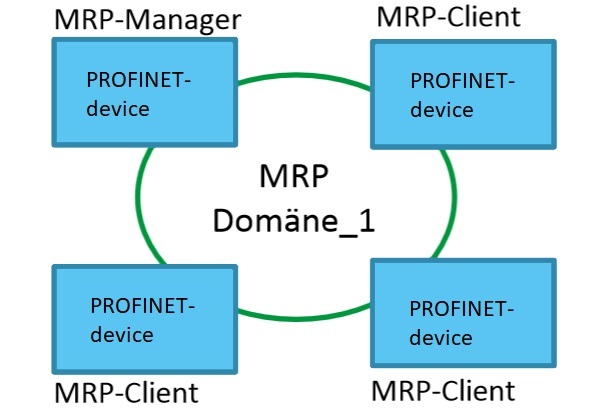MRP-Ring


MRP Ring = Media Redundancy Protocol. Redundant physical ring topologies are designed in industrial networks such as PROFINET or Industrial Ethernet, i.e. the free ends of a linear network topology are connected together to form a ring. The media redundancy protocol available for this purpose ensures a loop-free network topology and the monitoring of communication interruptions.
Why do I need an MRP ring? In order to increase productivity and quality in industrial production, the availability of automated machines and systems must be maximized. If a machine or system fails, e.g. due to a cable break, high costs are incurred due to the loss of production and downtime. The goal is therefore reliability. This applies to all areas, such as factory or process automation, and countless industries, such as automotive, energy supply, food & beverage and logistics.
What are the advantages of an MRP ring? The failure of individual infrastructure only slightly disrupts cyclical communication and improves system availability enormously. Maintenance can be carried out without time pressure during planned downtimes. Thanks to network diagnostics, troubleshooting can be carried out faster and in a more targeted manner. Ultimately, this can minimize downtime costs and downtimes.
Additional advantages:
From a network planning perspective, MRP rings are both a blessing and a curse. If a port or connection line in the ring fails, this disruption to the production process can be overcome quickly and there is no prolonged downtime. This results in a reconfiguration which, depending on the protocol and size of the network, causes a network failure of around 200 ms or more. In most systems, this downtime is not bridged by the interaction of update time and watchdog. In most cases, the reconfiguration of the ring is completed by the time it is restarted and the error is acknowledged.
This means that the MRP ring has superficially fulfilled its task and production is almost interruption-free. The maintenance worker didn't have to be called into action in the middle of the night either. The downside is that many of these networks are inadequately monitored or not monitored at all. In this case, the maintenance technician does not receive the crucial information that an error has occurred. Only when a subsequent error occurs does he suddenly have to search for two errors because the first one was never detected and eliminated.
In addition, the behavior of the ring protocol is often not taken into account during planning. The ring manager checks whether the ring is closed and blocks the 2nd port of the closed ring for the transmission of data traffic by default. The data stream is therefore built up as a line. The line depths are often underestimated, especially with regard to the downstream connections to other modules outside the ring. Network loads are added up for all participants in the ring.
During planning, a high-performance backbone (switch-switch connection) is often not set up to absorb unplanned network loads. The entire network load is routed via all ring participants (including I/O modules), which often leads to problems because the I/O modules cannot forward the resulting network load. The result is sporadic and non-reproducible
 MRP ring: The ring is closed, port 2 is blocked by default
MRP ring: The ring is closed, port 2 is blocked by default
 MRP ring: Cable break, the ring is open, both ports are now open to reach every participant
MRP ring: Cable break, the ring is open, both ports are now open to reach every participant
Conclusion: MRP rings are a possible way to protect critical and error-prone systems and networks from failures. However, the structure, behavior, line depth and device selection must be taken into account. In addition, a central network management system including a condition monitoring tool is recommended so that the maintenance technician has the opportunity to detect and eliminate errors as quickly as possible.
Do you need support?
Please feel free to arrange an initial conversation with our network expert to discuss your questions and specific requirements and to receive targeted tips for network structure, network load planning and network design.

Seminar "Netzwerkplanung"
Schaffen Sie eine zukunftsfähige Netzwerkstruktur. Wir zeigen Ihnen, wie Sie leistungsfähige und beherrschbare Industrie-Netzwerke schaffen.